 Click To Return To Main Page |
 |
||||||||
 News |
 Eco-Journalists |
 Articles |
 Games |
 Links |
 Facts 'n Fun |
 Email Us |
 About Us |
 Guestbook |
|
|
What's In The Fish You Eat?
Photo: M.Sewell and C.Sansom
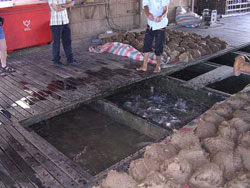
Photo: J. Todd
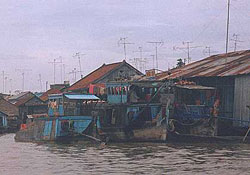 There is now a ban on fishing in Sydney Harbour due to the fact that fishes have increased their dioxin ( a poisonous chemical ) levels by 100 times. High levels of dioxin can cause cancer! They are ingesting ( taking in ) chemicals such as pesticides, lead, mercury, cadmium, and arsenic. So you have to be really careful where the fish you eat are from.
There is now a ban on fishing in Sydney Harbour due to the fact that fishes have increased their dioxin ( a poisonous chemical ) levels by 100 times. High levels of dioxin can cause cancer! They are ingesting ( taking in ) chemicals such as pesticides, lead, mercury, cadmium, and arsenic. So you have to be really careful where the fish you eat are from.
One of our favourite and most popular (and cheap) types of fish is called "Basa", which we just found out is actually a type of catfish! The flesh is sweet and white, it doesn't smell and it's just yummy. Now here's the bad news.... Basa or Mekong River Catfish (Pangasius bocourti ) is bred in the Mekong River ( this is one of the world's most polluted rivers ) in metal-barred cages and often under houseboats where 'sewage' (and we all know what that is!!!!!) and food scraps are directly dispersed in the water - blah!!!!!!!!!!!!!!! Chemicals such as sodium tripolyphosphate (STTP) which absorbs water to help it freeze for transportation, are often (but not always) added to fish. STTP's are considered safe in food and are also found in animal feeds, toilet cleaners and dishwashing powders. When added to fish, it is generally in the ratio of 5% STTP to fish. A few times when we cooked Basa fish, the amount of water that came out of it was unbelievable! So, we decided to do an experiment to show how much water is being added to the Basa. Not only is it healthier to avoid chemicals, but it also means that you are paying for water instead of fish! What can we do? Buy your fish from a fish shop that you trust and will tell you the truth about where your fish is from and the process used to freeze it. Write to the supermarket and ask them to buy fish which has not been frozen using STTP. Buy only fresh fish (that hasn't been frozen). Don't think that just because it's not frozen in the display that it's never been frozen. Frozen fish is usually thawed out before customers buy it. Imogen's Fishy Experiment. First I went to Woolworths and bought a slice of Basa fish which had been frozen. It was dead cheap at only $8.99 per kilo. Then I went to the fish shop and bought a slice of Barramundi which they told us was fresh (had not been frozen). Here I am cutting the fish so that each piece weighs the same
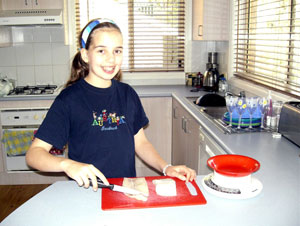
Each piece is cooked seperately for the same length of time
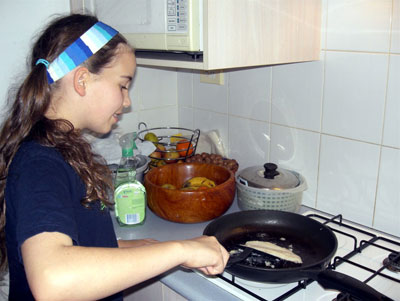 We weighed each piece and cut them to make sure they weighed the same.
We weighed each piece and cut them to make sure they weighed the same.
Each piece was cooked seperately for the same amount of time. Then each piece was weighed. Each piece of fish had lost weight (the effects of losing some water during the cooking process) but neither fish had lost a huge amount and not much water had come out of the Basa whilst cooking. Conclusion: Oh dear! Well, that blew my experiement. The Basa fish I bought obviously had not had any of the water absorbing chemical added to it. Which is good.....but not for my experiment. The experiment didn't work but it doesn't matter because it's an edible experiment!
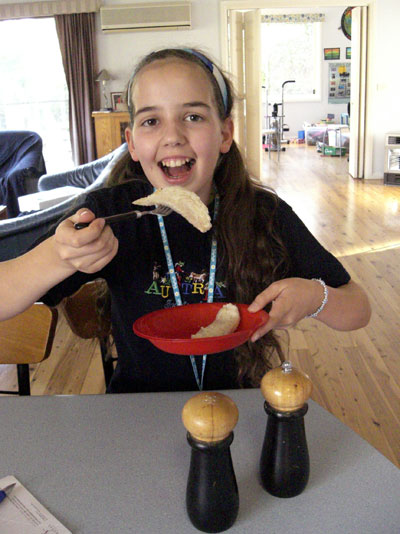 Maybe you could do this experiment at home and let me know if your results are any different. Our advice to you is to know what you're buying and to only eat fish once a week. Fish are becoming scarce because we catch too many. Some fish eat from the sea bottom and tend to have higher levels of mercury (a dangerous chemical which builds-up in our bodies if we eat it). Take a look at Alastair's story 'There's Something Fishy' Try to buy ecologically sustainable types of fish. Read Alastair's story 'Something's Fishy' in our 'previous articles' section; it tells you exactly which fish to buy and which to avoid. DON'T LET YOUR PARENTS BUY ORANGE ROUGHY!. Story by Imogen Wadlow
References: http//en.wikipedia.org/wiki/Sodium_tripolyphosphate
Photos: Julian Todd - www.goatchurch.org.uk Aaron Huynh @ Flickr |